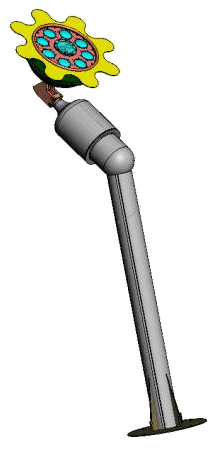

The Sunflowers project was carried out in collaboration with the CEO Consortium -
Optronic Center of Excellence in Florence and the Stibbert Museum in Florence, financed by Banca Monte Paschi Siena and the Region of Tuscany.
The project involved the development of an interior lighting system by concentrating sunlight on optical fibers. This system was applied to the lighting of some showcases of the Stibbert Museum in Florence.
The system was called "I Girasoli" for the property of the solar collector to follow the position of the sun during the day. Each sunflower includes a series of solar collectors, optical fibers and the mechanical and electronic systems that allow tracking of the sun.
The light focused by the collectors has two possible uses, determined by a sensor of the presence of people placed in the hall of the museum.
The two functions are:
Work on the exploitation of sunlight began with the European project Spectrum , during which an optical system for concentrating sunlight was developed. A solar light collection system was built and tested to provide energy for domestic use.
Starting from the optics studied for the Spectrum project, the realization of optical components in plastic was studied, which allow a mass production at limited costs. For the Sunflowers concentrator project, the configuration of the CCM of the Spectrum project was modified, in order to create a single plastic aspherical lens. This is to allow the reduction of production costs, with a realization per mold. The sample made of the new lens also has a significantly reduced weight and size compared to the CCM. The final result is a PMMA aspherical lens with reduced weight and dimensions. Similarly, silicon fibers have been replaced with plastic fibers which have the advantage of being much more flexible, having a lower price and longer life.
Each collector is coupled with a bundle of optical fibers, the terminations of which are used for lighting the shop windows. The arrangement of the terminations has been designed to have the maximum uniformity of light.
The sunlight focused on the optical fibers comes out of the terminations in the windows after traveling about 30m. The spectral absorption of the fibers produces a change in the color of the light, as evidenced by the spectral study. It was therefore necessary to use suitable filters to restore the color of the light to a warmer shade, as recommended by the Museum's experts.
This improved system was used to create the lighting inside the display cases of the Islamic Room of the Stibbert Museum. The fundamental elements of the system are the solar collectors and optical fibers.
Each Sunflower is composed of solar collectors, optical fibers and optoelectronics as well as the mechanics necessary for tracking the sun.
The light focused by the collectors has two possible uses: direct lighting of shop windows or the production of electricity.
The installation at the Stibbert Museum consists of two parts: a group of Sunflowers is placed in the garden, while the other is on the roof above the Islamic Room.
CNR-INO Istituto Nazionale di Ottica - Largo Fermi 6, 50125 Firenze - Tel. +39 05523081 - P.iva 02118311006 - Info: info@ino.cnr.it